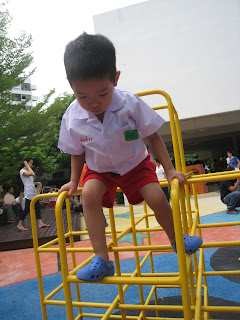Homeschooling
Homeschooling or homeschool (also called home education or home
based learning) is the education of children at home, typically by parents
or by tutors, rather than in
other formal settings of public or private
school. Although prior to the introduction of compulsory school attendance laws, most
childhood education occurred within the family or community, homeschooling
in the modern sense is an alternative in developed
countries to attending
public or private schools. Homeschooling is a legal option for parents in many
countries, allowing them to provide their children with a learning environment
as an alternative to public or private schools outside the individual's home.
Parents cite numerous reasons as motivations to homeschool
their children. The three reasons that are selected by the majority of
homeschooling parents in the United States are concern about the school
environment, to provide religious or moral instruction, and dissatisfaction with
academic instruction at public and private schools. Homeschooling may also be a
factor in the choice of parenting style. Homeschooling can be an option
for families living in isolated rural locations, living temporarily abroad, to
allow for more traveling, while many young athletes and actors are taught at
home. Homeschooling can be about mentorship and apprenticeship, where a tutor
or teacher is with the child for many years and then knows the child very well.
Homeschooling can
be used as a form of supplementary education, a way of helping children learn,
in specific circumstances. For instance, children that attend downgraded
schools can greatly benefit from homeschooling ways of learning, using the
immediacy and low cost of the Internet. As a synonym to e-learning, homeschooling can
be combined with traditional education and lead to better and more complete
results. Homeschooling may also refer to instruction in the
home under the supervision of correspondence schools or umbrella
schools. In some places, an approvedcurriculum is legally required if children are to
be home-schooled. A
curriculum-free philosophy of homeschooling may be called unschooling,
a term coined in 1977 by American educator and author John Holt in his magazine Growing Without Schooling. In some
cases, a liberal arts education is provided using the trivium and quadrivium as the main model.
(credit: http://en.wikipedia.org/wiki/Homeschooling
การศึกษาแบบโฮมสกูล หรือ การศึกษาแบบบ้านเรียน
นับตั้งแต่พระราชบัญญัติการศึกษาแห่งชาติ
พ.ศ. 2542 ประกาศใช้
การจัดการศึกษาโดยครอบครัวเป็นสิทธิโดยถูกต้องตามมาตรา
12 ที่ให้ครอบครัวจัดการศึกษา ขั้นพื้นฐานได้ เป็นทางเลือกของครอบครัว
ที่ประสงค์จะจัดการศึกษาให้กับบุตรเอง หากไม่ประสงค์จะส่งลูกเข้าโรงเรียน โดยสภาพความเป็นจริงการจัดการโดยครอบครัว
ได้มีการดำเนินงานมาบ้างแล้วก่อนประกาศใช้พระราชบัญญัติการศึกษาแห่งชาติฯ
แม้จะมีจำนวนไม่มาก เท่าที่มีข้อมูลประมาณ
2-3 ครอบครัว
หลังจากพระราชบัญญัติการศึกษาแห่งชาติฯ ประกาศใช้ การดำเนินงานในเรื่องนี้ได้มีการศึกษาองค์ความรู้จากต่างประเทศ
เพื่อนำไปสู่การดำเนินงานที่เป็นรูปธรรมสอดคล้องกับประเทศไทย
พร้อมทั้งได้มีครอบครัวที่ตัดสินใจดำเนินการจัดการศึกษาให้ลูก
ตามสิทธิที่ครอบครัวได้รับโดยถูกต้องตามกฎหมาย ทั้งนี้ตามพระราชบัญญัติการศึกษาแห่งชาติฯ มาตรา 12 สิทธิการจัดการศึกษาขั้นพื้นฐานโดยครอบครัวนี้
จะต้องเป็นไปตามกฎกระทรวง กฎกระทรวงว่าด้วยสิทธิการจัดการศึกษาขั้นพื้นฐาน
โดยครอบครัวอยู่ระหว่างดำเนินการ โดยกระทรวงศึกษาธิการ
ความหมาย
การศึกษาโดยครอบครัว หมายถึง
การศึกษาขั้นพื้นฐานที่ครอบครัวจัดโดยสิทธิคุ้มครองตามกฎหมาย
ซึ่งมีรูปแบบการจัดการศึกษาแบบใดแบบหนึ่งหรือทั้งสามรูปแบบ
ของการศึกษาในระบบ การศึกษานอกระบบ
และการศึกษาตามอัธยาศัย อย่างมีการเทียบโอนผลการศึกษาได้
ลักษณะเด่น
การจัดการศึกษาโดยครอบครัวของไทยมีลักษณะเด่น
5 ประการ ดังนี้
1. เป็นการจัดการศึกษาที่พ่อแม่ หรือผู้ปกครองเป็นผู้รับผิดชอบโดยตรง เป็นการจัดการศึกษาเองทั้งหมด
หรือโดยมีข้อตกลงจัดการศึกษาร่วมกันระหว่างครอบครัวกับโรงเรียน
อาจเป็นผู้สอนด้วยตนเอง หรืออำนวยการให้เกิดการเรียนการสอนขึ้น
2. มีการจัดตั้งเป็นศูนย์การเรียนครอบครัวเดี่ยว
หรือศูนย์การเรียนกลุ่มครอบครัว (บางครอบครัวอาจเลือกที่จะไม่เป็นศูนย์การเรียนก็เป็นไปได้)
3. สาระและกระบวนการเรียนรู้ต่างๆ
ที่จัดขึ้น เป็นไปในทางตอบสนองต่อปรัชญา
ทัศนะ ความเชื่อ
ความสนใจ ความต้องการหรือปัญหาของแต่ละครอบครัว
จึงเป็นนวัตกรรมทางการศึกษาที่มีความแตกต่างหลากหลายกันไป
มีความยืดหยุ่นเป็นอิสระ
4. ความสำเร็จของการศึกษา
มุ่งไปที่การพัฒนาศักยภาพเด็กเป็นรายบุคคล อย่างพยายามให้สอดคล้องกับความถนัด ความสนใจ
และความต้องการที่มีอยู่จริง จากการเป็นหน่วยการศึกษาขนาดเล็กที่สามารถสร้างกระบวนการเรียนรู้แบบตัวต่อตัว
และผสมผสานไปกับวิถีการดำเนินชีวิต
5. ไม่ใช่การศึกษาที่เป็นกิจการทางธุรกิจเพื่อผลกำไร
และไม่เป็นไปเพื่อการแอบอ้างแสวงหาผลประโยชน์จากเด็ก
รูปแบบการดำเนินงาน
การจัดการศึกษาโดยครอบครัว รูปแบบการดำเนินงานมีดังนี้
1. การดำเนินงานโดยครอบครัวเดี่ยว ในช่วงแรกๆ ที่ผ่านมา
รูปแบบจะเป็นไปในลักษณะนี้ เนื่องจากสถานการณ์แวดล้อมที่ทำให้ต้องเป็นไปในลักษณะเช่นนี้
การดำเนินงานมีความเป็นปัจเจกค่อนข้างสูง หลักสูตร กระบวนการเรียนการสอนเป็นไปตามวิถีสภาพแวดล้อมของครอบครัว
ความคิด ความเชื่อ
ความสนใจ มีความหลากหลายแตกต่างกัน
มีลักษณะเฉพาะของแต่ละครอบครัวค่อนข้างสูง แต่ขณะเดียวกันก็มีสังคมกลุ่มเพื่อนมีความเชื่อมโยง เกิดกิจกรรมที่นำไปสู่การจัดการศึกษาร่วมกัน เช่น ครอบครัวพึ่งอุดม
2. การดำเนินงานโดยกลุ่มครอบครัวข่ายประสานงาน
ลักษณะการดำเนินงานหลายครอบครัวร่วมกันดำเนินงานในบางกิจกรรมอย่างต่อเนื่อง
แต่ขณะเดียวกันมีอิสระในวิถีของตัวเอง มีการจัดการศึกษาทั้งที่บ้านของแต่ละครอบครัว พร้อมไปกับการจัดการศึกษาร่วมกันของกลุ่มตามที่นัดหมาย
มีการบริหารจัดการที่กระจายไปแต่ละครอบครัว มากกว่ารวมศูนย์การบริหารอยู่ที่เดียว เช่น
กลุ่มบ้านเรียนปัญญากร
3. การดำเนินงานโดยกลุ่มครอบครัว
แบบรวมศูนย์การจัดการในที่เดียว ครอบครัวหลายครอบครัวรวมกันจัดการศึกษา
ในที่แห่งหนึ่ง มีคณะครอบครัวทำหน้าที่เป็นคณะกรรมการกำกับดูแลในเรื่องนโยบายและการบริหารจัดการ
การดำเนินงานมีการมอบหมาย หรือจ้างคณะทำงาน
ทำหน้าที่บริหารจัดการ มีความต่างจากโรงเรียนดังนี้
3.1 เป็นโรงเรียนของครอบครัว ครอบครัวเป็นเจ้าของโดยมีแนวความเชื่อ จุดมุ่งหมาย
ปรัชญาการศึกษา ยึดถือร่วมกัน
3.2 เป็นโรงเรียนขนาดเล็ก จัดให้เฉพาะลูกหลานในกลุ่ม ในปริมาณไม่มากนัก
3.3 เป็นโรงเรียนแบบการกุศล ไม่มุ่งแสวงหากำไร
รูปแบบนี้ แต่ละครอบครัวยังไม่พร้อมที่จะจัดการศึกษาด้วยตัวเองได้
ทั้งหมด เช่น สถาบันปัญโญทัย (นายแพทย์พร
พันธุ์โอสถ เป็นแกน)
การดำเนินงานรูปแบบนี้มีแนวโน้มที่จะเป็นการจัดการศึกษาโดยชุมชน
หรือองค์กรสังคม
4. ดำเนินการจัดการศึกษาโดยมีข้อตกลงร่วมกับทางโรงเรียน
ครอบครัวได้จัดการศึกษาโดยมีข้อตกลงร่วมกันกับทางโรงเรียน
ในด้านการบริหารจัดการ หลักสูตร
การเรียนการสอน เป็นบทบาทของครอบครัว
การวัดประเมินผลร่วมกันระหว่างโรงเรียนกับครอบครัว
โดยโรงเรียนออกใบรับรองให้กับผู้เรียน พร้อมทั้งอนุญาตให้ใช้สถานที่ ห้องปฏิบัติการ
อุปกรณ์การเรียนการสอน การจัดทำกิจกรรมเสริมหลักสูตร
ตลอดจนใช้สถานที่ในการพบปะสังสรรค์ มีกิจกรรมสังคมร่วมกับคณะคณาจารย์และนักเรียนในโรงเรียน
การดำเนินงานรูปแบบนี้ครอบครัวและโรงเรียนได้มีการถ่ายทอดแลกเปลี่ยนการเรียนรู้ซึ่งกันและกัน
เช่น กลุ่มครอบครัวบ้านเรียนชวนชื่น
การเรียนการสอน
การจัดการศึกษาโดยครอบครัว มีการจัดการเกี่ยวกับการเรียนการสอนอันได้แก่
รูปแบบการจัดการศึกษา หลักสูตร
การประเมินผล ดังนี้
1. รูปแบบการจัดการศึกษา
การจัดการศึกษาโดยครอบครัว ได้มีการจัดการศึกษาทั้ง
3 รูปแบบ คือ
การศึกษาในระบบ การศึกษานอกระบบ
การศึกษาตามอัธยาศัย ซึ่งมีทั้งที่เป็นการจัดการศึกษารูปแบบใดรูปแบบหนึ่ง
หรือทั้งสามรูปแบบผสมผสานกัน ในสังคมส่วนใหญ่มีลักษณะผสมผสาน
ค่อนไปในเป็นการศึกษานอกระบบ และการศึกษาตามอัธยาศัย
ทั้งนี้เป็นไปตามรูปแบบการจัดการศึกษาที่แต่ละครอบครัวเลือก
กล่าวคือ
1.1 ครอบครัวที่เลือกจัดการศึกษาแบบการศึกษาในระบบ
จะมีการกำหนดจุดมุ่งหมาย วิธีการศึกษา
หลักสูตร ระยะเวลาการศึกษา
การวัดประเมินผลตามเงื่อนไขของการสำเร็จการศึกษาที่แน่นอน
1.2 ครอบครัวที่เลือกจัดการศึกษาแบบนอกระบบ
มีการกำหนดจุดมุ่งหมาย วิธีการศึกษา
หลักสูตร ระยะเวลา
การวัดประเมินผล อย่างยืดหยุ่น
สอดคล้องกับสภาพและความต้องการของแต่ละครอบครัว
1.3 ครอบครัวที่เลือกจัดการศึกษาตามอัธยาศัย
การกำหนดจุดมุ่งหมาย วิธีการศึกษา
หลักสูตร ระยะเวลา
การวัดประเมินผล ยิ่งมีความยืดหยุ่นและมีอิสระมากขึ้น
เป็นไปตามความสนใจ ศักยภาพ
ความพร้อมและโอกาส สามารถศึกษาเรียนรู้ได้ทุกสถานการณ์
2. หลักสูตร
การจัดการศึกษาโดยครอบครัว กำหนดหลักการและความมุ่งหมายการจัดสาระการเรียนรู้ที่นำไปสู่ความเป็นมนุษย์ที่สมบูรณ์ของผู้เรียน
การกำหนดเนื้อหาสาระการเรียนรู้จึงมีความยืดหยุ่น
การดำเนินงานในช่วงเริ่มต้นใช้เนื้อหาสาระหลักสูตรของกระทรวงศึกษาธิการ
ควบคู่ไปกับหลักสูตรโรงเรียนสาธิต โรงเรียนนานาชาติ หรือต่างประเทศ
โดยยืดหยุ่นเป็นไปตามความพร้อมและความสนใจของลูกเป็นสำคัญ
ต่อมาได้มีการพัฒนา
ด้วยการสร้างหลักสูตรของครอบครัว มีการกำหนดกรอบกว้างๆ
ที่เป็นความตกลงและเตรียมการร่วมกันระหว่างพ่อแม่และลูก
โดยให้ความสำคัญกับองค์ความรู้ หรือกระบวนการเรียนรู้หลายๆ
สายผสมผสานกัน ที่สามารถหล่อหลอมคุณลักษณะการเรียนรู้ของเด็กมากกว่าตัวความรู้
ให้ใฝ่รักการเรียนรู้และวิธีการเรียนรู้ให้สามารถสร้างเสริมความรู้ได้ตลอดชีวิต
มากกว่าความรู้อย่างเป็นส่วนๆ
การเรียนรู้ของครอบครัวเกิดขึ้นได้ทุกเวลา
ทุกสภาพการณ์ อย่างเป็นธรรมชาติ
แทรกซึมในวิถีชีวิต การเรียนรู้เป็นพัฒนาการที่เกิดขึ้นในตัวเด็ก
หลักสูตร
Home School มีลักษณะสังเขป
ดังนี้
- ขอบเขตเนื้อหาวิชาไม่ต่างไปจากหลักสูตรปกติ
- ข้อแตกต่างสำคัญอยู่ที่กระบวนการเรียนการสอนที่ยืดหยุ่น
- มีการจัดประสบการณ์เสริมการเรียนรู้อย่างหลากหลาย
- มีกิจกรรมนอกบ้านเป็นองค์ประกอบสำคัญ
- มีการใช้ประโยชน์จากิจกรรมเครือข่ายพ่อแม่
Home School
3. การประเมินผล
การประเมินผลการจัดการศึกษาโดยครอบครัว มีการประเมินผลอย่างเป็นทางการ ที่ปฏิบัติอยู่
ดังนี้
1. ครอบครัวที่ลูกอยู่ในระดับการศึกษาภาคบังคับ
นำชื่อลูกไปฝากไว้กับโรงเรียน โรงเรียนได้ดำเนินการวัดผล
ประเมินผล มีการสอบเลื่อนระดับชั้นร่วมกับนักเรียนของโรงเรียน
สำเร็จการศึกษาชั้นประถมศึกษาปีที่
6 จากการเข้าสอบไล่และใช้ข้อสอบเดียวกับโรงเรียน
2. ครอบครัวที่ลูกโตกว่าระดับการศึกษาภาคบังคับ
ใช้วิธีการเข้ากลุ่มเรียนเสริมและสอบเทียบกับการศึกษานอกระบบ
ของกรมการศึกษานอกโรงเรียน
อย่างไรก็ตาม
แนวทางการประเมินผลของการจัดการศึกษาโดยครอบครัว
มีหลักความคิดที่สำคัญ ดังนี้
- มุ่งพัฒนาการของเด็กอย่างแท้จริง
- ใหัความสำคัญกับพัฒนาการเป็นรายบุคคลเพื่อให้เด็กได้ค้นพบวิถีทางพัฒนาตัวเอง
- เปิดโอกาสให้เด็กมีส่วนร่วมในการประเมินผลตัวเองด้วย
- ให้ความสำคัญในการประเมินจากสภาพจริง
มากกว่าการสอบ การใช้แบบทดสอบ
- มีความต่อเนื่องเห็นตลอดทั้งกระบวนการมากกว่าเพียงชิ้นงานที่เป็น
ผลลัพธ์ในขั้นสุดท้าย
- มีความหลากหลายในวิธีการ ทั้งอย่างเป็นทางการและไม่เป็นทางการ ตามหลักที่ทุกสิ่งทุกอย่างล้วนเป็นการเรียนรู้และสามารถใช้เป็นประจักษ์พยานแสดงผลของการเรียนรู้ได้ทั้งสิ้น
- การสังเกตลูกอย่างใกล้ชิดและมีสัมผัสความเป็นพ่อแม่
เป็นวิธีการที่เป็นธรรมชาติ เกิดขึ้นจริง
และได้ผลมากที่สุด ของการประเมินพัฒนาการของลูกภายในครอบครัว
หลักฐานแสดงผลการศึกษา
การจัดการศึกษาโดยครอบครัว มีหลักฐานที่แสดงผลการศึกษาของเด็กที่เป็นรูปธรรม
ส่วนใหญ่ประกอบด้วยสิ่งต่อไปนี้
- สมุดบันทึก และแฟ้มสะสมงานของพ่อแม่
แสดงปัญหา การแก้ปัญหา
การพัฒนาการเรียนการสอน และพัฒนาการของผู้เรียนรายบุคคล
เป็นต้น
- แฟ้มสะสมงานของลูก ในทุกประสบการณ์การเรียนรู้และเนื้อหาความรู้
- สมุดบันทึกของลูก เช่น
บันทึกส่วนตัว (ทัศนะ
ประสบการณ์ใหม่ เจตจำนง)
บันทึกแหล่งเรียนรู้ (จากการเดินทาง
ทัศนศึกษา) สมุดภาพ
เป็นต้น
- ผลงานที่นำเสนอในการเรียนรู้ในรูปแบบโครงงาน
ทั้งโดยบุคคลและโดยกลุ่ม
แนวทางการดำเนินงาน
ครอบครัวที่ตัดสินใจจัดการศึกษาขั้นพื้นฐานให้กับลูกจะต้องนำชื่อลูกไปจดทะเบียนกับโรงเรียนที่ยินดีรับ
ทั้งนี้ด้วยพระราชบัญญัติการประถมศึกษา ได้ระบุว่าเด็กอายุครบ 6 ปีบริบูรณ์จะต้องเข้าโรงเรียน
เพื่อให้เป็นไปตามกฎหมายที่ใช้อยู่ปัจจุบันเด็กทุกคนที่มีอายุครบ
6 ปีบริบูรณ์จึงต้องมีชื่ออยู่ในโรงเรียน
การจัดการศึกษาโดยครอบครัวเป็นสิทธิที่ถูกต้องตามพระราชบัญญัติการศึกษาแห่งชาติฯ
แต่สิทธิที่ได้รับนี้จะต้องมีกฎกระทรวงรองรับ ดังนั้นในช่วงที่กฎกระทรวงยังไม่ได้มีผลบังคับใช้ การดำเนินงานจึงจำเป็นต้องให้สอดคล้องกับระเบียบ กฎ ต่างๆ ที่ใช้บังคับอยู่
การที่เด็กขึ้นทะเบียนกับโรงเรียน ก็ต้องมีความตกลงร่วมกันระหว่างโรงเรียนกับครอบครัว ในเรื่องการเรียนการสอน การจัดกิจกรรมการเรียนรู้
การวัดประเมินผล รวมทั้งหลักฐานการเรียนที่จำเป็น
ปัจจุบันมีโรงเรียนที่รับ
Home School จดทะเบียน มี 2 แห่ง
ได้แก่
1. โรงเรียนหมู่บ้านเด็ก
ต.วังด้ง อ.เมือง
จ.กาญจนบุรี 71190
2. โรงเรียนสัตยาไส
ต.ลำนารายณ์ อ.ชัยบาดาล
จ.ลพบุรี (เริ่มรับครอบครัวจดทะเบียน
ปีการศึกษา 2545)
จำนวนการจัดการศึกษาโดยครอบครัว ปัจจุบันมีจำนวน
86 ครอบครัว เด็กจำนวน
108 คน
จำนวนที่จดทะเบียนกับโรงเรียนเป็นดังนี้
- โรงเรียนหมู่บ้านเด็ก
80 ครอบครัว เด็ก
98 คน



















